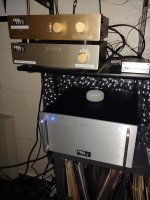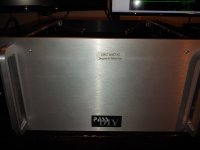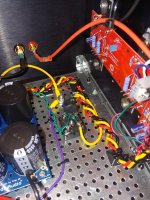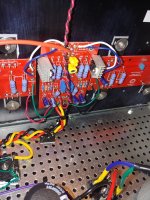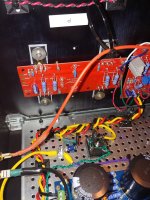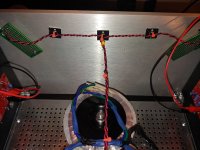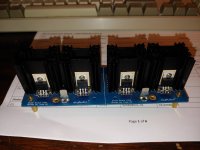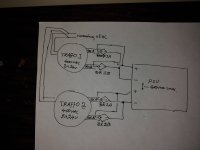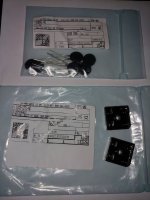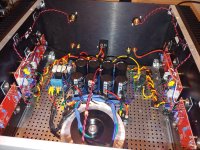Finally finished my F5 turbo. It's been a journey. I had significant problems with hum which I traced back to a combination of transformer issues and dc pollution on the mains
I couldn't get a 600VA (AN-6224)transformer to behave properly on my mains. I tried a 500VA 2x24v (AN-5224) and it wouldn't work properly either. I built a DC blocker and that made some difference, but not enough for a listenable amplifier.
I finally tried a shielded 400VA 2x24v (AS-4224) transformer and it is working perfectly. No more hum.
If I were to attempt to rebuild this amp in the future I would not choose a large VA transformer (too unpredictable) and instead I would use either an AS-3224 or AS-4224 in dual power supply configuration i.e. a separate power supply for each channel only connected at the main star ground.
It works out a little more expensive but a lot less problems I think. All these transformers I sourced from Antek inc. here in the US.
I've included some photo's of the finished build.
I'm going to run the amp in using the 400VA transformer for a while to see how it performs. If I have problems I will switch to a dual PSU solution.
I couldn't get a 600VA (AN-6224)transformer to behave properly on my mains. I tried a 500VA 2x24v (AN-5224) and it wouldn't work properly either. I built a DC blocker and that made some difference, but not enough for a listenable amplifier.
I finally tried a shielded 400VA 2x24v (AS-4224) transformer and it is working perfectly. No more hum.
If I were to attempt to rebuild this amp in the future I would not choose a large VA transformer (too unpredictable) and instead I would use either an AS-3224 or AS-4224 in dual power supply configuration i.e. a separate power supply for each channel only connected at the main star ground.
It works out a little more expensive but a lot less problems I think. All these transformers I sourced from Antek inc. here in the US.
I've included some photo's of the finished build.
I'm going to run the amp in using the 400VA transformer for a while to see how it performs. If I have problems I will switch to a dual PSU solution.
Attachments
I've biased the channels at 350mv with 4-5mv offset on the speakers. So far so good it sounds really good.
^ The cans are brilliant IMO, I have several. However, they don't likely prevent the type of hum they're describing. I think they had actual mechanical hum from the transformer itself vs. EMI causing hum by coupling with the signal or DC supplies etc.
The shielded 'AS' Antek's may have less mechanical hum (compared to their 'AN' brethren) or hum less with DC on the mains b/c of the shield itself and it's electrical function along with a general theory that they're wound tighter / packaged more tightly / have the gauss band for additional support. I don't know for certain that's true, but it makes sense to me. Also, smaller transformers seem generally less likely to have mechanical hum unless oversaturation of the core is what's causing the hum. That's not likely in this case since they actually went to a smaller VA transformer (and just given the specs of the transformer vs. the amplifier).
The cans are great with EMI. Also, the cans may obscure some of the mechanical noise just due to the transformer being enclosed in a can. However, for simply covering up the noise and making it less audible at the listening chair ... any old can material will do and I don't know that I'd go to the expense of the Antek ones, unless it's for looks.
As always... I'm not disagreeing, but offering some opinions and addition perspective. I love those cans though. They look fabulous, and in tight spaces, I know they help with noise/hum. Rotating my Antek toroids to lower noise is now a thing of the past. I still try to use careful layout and wire management, but the cans make it much easier (for me).

Also @dpogorman - Antek has been known to offer replacements for humming transformers. It may be too much trouble given your location and potential shipping costs, but it could be worth a shot. This is only if the transformer wasn't abused etc., which I'd guess is the case. You may find another use for them ... or if it actually is DC on the mains, you may have some ways to get around that and still use the transformers for another project.

The shielded 'AS' Antek's may have less mechanical hum (compared to their 'AN' brethren) or hum less with DC on the mains b/c of the shield itself and it's electrical function along with a general theory that they're wound tighter / packaged more tightly / have the gauss band for additional support. I don't know for certain that's true, but it makes sense to me. Also, smaller transformers seem generally less likely to have mechanical hum unless oversaturation of the core is what's causing the hum. That's not likely in this case since they actually went to a smaller VA transformer (and just given the specs of the transformer vs. the amplifier).
The cans are great with EMI. Also, the cans may obscure some of the mechanical noise just due to the transformer being enclosed in a can. However, for simply covering up the noise and making it less audible at the listening chair ... any old can material will do and I don't know that I'd go to the expense of the Antek ones, unless it's for looks.
As always... I'm not disagreeing, but offering some opinions and addition perspective. I love those cans though. They look fabulous, and in tight spaces, I know they help with noise/hum. Rotating my Antek toroids to lower noise is now a thing of the past. I still try to use careful layout and wire management, but the cans make it much easier (for me).

Also @dpogorman - Antek has been known to offer replacements for humming transformers. It may be too much trouble given your location and potential shipping costs, but it could be worth a shot. This is only if the transformer wasn't abused etc., which I'd guess is the case. You may find another use for them ... or if it actually is DC on the mains, you may have some ways to get around that and still use the transformers for another project.

Dear Starcat,
Thanks for your reply. I'm pretty sure we have dirty AC here where I'm living. I've used dc blockers to try and clean it up, but it's not always a true cure. Both the 600VA and 500VA transformers I used had both mechanical hum (caused by dc in the mains) and (particularly the 600VA traffo) radiated EMI into the audio circuit. I built a BA-3 (32v -40W output) using the AS-4224 and that was silent in comparision to the F5-T using the larger transformers. I also built a standard F5 using the Antek AS-3218 transformer and it was also silent using a shielded transformer. The issue here where I'm living is simply polluted AC mains.
I ran the new F5-Turbo with the 400VA transformer and yes, we have hum coming from this transformer too. In this case, however, I think it is because the transformer is being asked to do too much with the power demands of the amplifier.
I could start contemplating doing crazy things like getting a separate line circuit installed in my house just for audio, but that seems to be the point when this stops being fun and entertainment and starts to resemble work/obsessive behavior......LOL
Thanks for your reply. I'm pretty sure we have dirty AC here where I'm living. I've used dc blockers to try and clean it up, but it's not always a true cure. Both the 600VA and 500VA transformers I used had both mechanical hum (caused by dc in the mains) and (particularly the 600VA traffo) radiated EMI into the audio circuit. I built a BA-3 (32v -40W output) using the AS-4224 and that was silent in comparision to the F5-T using the larger transformers. I also built a standard F5 using the Antek AS-3218 transformer and it was also silent using a shielded transformer. The issue here where I'm living is simply polluted AC mains.
I ran the new F5-Turbo with the 400VA transformer and yes, we have hum coming from this transformer too. In this case, however, I think it is because the transformer is being asked to do too much with the power demands of the amplifier.
I could start contemplating doing crazy things like getting a separate line circuit installed in my house just for audio, but that seems to be the point when this stops being fun and entertainment and starts to resemble work/obsessive behavior......LOL
I've had an idea for a solution to my power supply problem.
I was watching the video of the diyaudio implementer on youtube where he is building an Aleph J amplifier. He had an interesting solution to his own transformer issues. He was unable to source a transformer of the appropriate VA rating and secondary voltage so he bought two 250VA 2x18v transformers and wired the outputs from each in parallel and used one transformer to power the positive rail and the other to power the negative rail of the power supply. In effect he was supplying 250VA to each rail for a total of 500VA.
He used two bridge rectifiers and tied the secondaries together. I'm not going to do that, I think I have a more elegant solution. From a previous project I built up the rectifier boards from the universal power supply but I never used them. They've sat on a shelf for the last 3 years gathering dust. I've included a photo below and if you look at where the transformer feeds are attached - AC1B and AC2B there are holes for attaching transformer feeds in parallel (on the other sides of the heatsinks are located AC1A and AC2A). At the moment I have a blade inserted in the holes for 'faston' connectors, but I can remove them.
I happen to have a second AS-4224 transformer in another project (BA-3) that I'm willing to put into the F5 Turbo.
So it's going to be a kind of quasi dual mono power supply unit without having to build a second PSU board, and as a bonus I will have a total of 800VA for the PSU
What does everyone think? Will this work? Or am I going to experience other negative outcomes?
Thanks in advance
I was watching the video of the diyaudio implementer on youtube where he is building an Aleph J amplifier. He had an interesting solution to his own transformer issues. He was unable to source a transformer of the appropriate VA rating and secondary voltage so he bought two 250VA 2x18v transformers and wired the outputs from each in parallel and used one transformer to power the positive rail and the other to power the negative rail of the power supply. In effect he was supplying 250VA to each rail for a total of 500VA.
He used two bridge rectifiers and tied the secondaries together. I'm not going to do that, I think I have a more elegant solution. From a previous project I built up the rectifier boards from the universal power supply but I never used them. They've sat on a shelf for the last 3 years gathering dust. I've included a photo below and if you look at where the transformer feeds are attached - AC1B and AC2B there are holes for attaching transformer feeds in parallel (on the other sides of the heatsinks are located AC1A and AC2A). At the moment I have a blade inserted in the holes for 'faston' connectors, but I can remove them.
I happen to have a second AS-4224 transformer in another project (BA-3) that I'm willing to put into the F5 Turbo.
So it's going to be a kind of quasi dual mono power supply unit without having to build a second PSU board, and as a bonus I will have a total of 800VA for the PSU
What does everyone think? Will this work? Or am I going to experience other negative outcomes?
Thanks in advance
Attachments
^ Numerous posts cautioning against paralleling transformers prior to rectification.
I find ZMs the most easy to understand re: potential for one transformer to load the other. He cautioned me on a different project. It hasn't stopped people from doing it, but it's worth knowing the risks. Since this deals with the AC side of things which I definitely don't have a full grasp on, I'll just echo the caution he gave me and let others with true direct knowledge advise. My post is simply to say that I'd pause until a smarter person than I says if it will work or not.
I find ZMs the most easy to understand re: potential for one transformer to load the other. He cautioned me on a different project. It hasn't stopped people from doing it, but it's worth knowing the risks. Since this deals with the AC side of things which I definitely don't have a full grasp on, I'll just echo the caution he gave me and let others with true direct knowledge advise. My post is simply to say that I'd pause until a smarter person than I says if it will work or not.
several ways of summing wattage of pair (or more) xformers ....... but one rule applies - whatever you do, do it after bridges
meaning - each xformer is having own bridge(s)
now, simply put - having two identical xformers, wanting bipolar (dual rail) PSU - one way is one xformer producing one rail, stacking xformers after the bridges........ and other way is as usual - each xformer producing both rails, paralleling xformers after the bridges
still best way - one xformer per channel, having own cap bank
meaning - each xformer is having own bridge(s)
now, simply put - having two identical xformers, wanting bipolar (dual rail) PSU - one way is one xformer producing one rail, stacking xformers after the bridges........ and other way is as usual - each xformer producing both rails, paralleling xformers after the bridges
still best way - one xformer per channel, having own cap bank
I've sketched up a drawing showing what I mean, as I don't think I explained it very before. The only reason I'm considering this scheme is I have been unable to get any un-shielded transformers over 400VA to operate reliably. Have a look and tell me where I'm going wrong. If this can work it saves me having to build a second PSU board and move everything in the chassis to make space for it.
Attachments
I don't think I understand how one transformer can load the other when the only connection between them is through the ground which is connected to the main earth
As far as I am aware the current inrush limiter board can handle up to 1.2KVA as a transformer load.
I don't have too firm a grasp on this.. admittedly. ZM is much better at explaining.I don't think I understand how one transformer can load the other when the only connection between them is through the ground which is connected to the main earth
Seeing your diagram, you're correct one would not load the other.
Thinking it through... it may be that one secondary being slightly different (not guaranteed, but maybe) could act as a load to the other if they're not perfectly wound.
Either way... mine is speculation. ZM actually really knows this. I just guess a bit based on my very limited knowledge.
Hope it all works out.
I see transformer secondaries connected in parallel to bridge rectifiers in the diagram in post #1,729. That can be a problem if the windings and voltage ratios of the two primary/secondary winding sets are not exactly identical. If the transformers are bifilar wound, then they probably are identical. If they are not identical, then bad things happen.
Having said that, I think Antek transformers are bifilar wound. But you can't go wrong with separate rectifiers for each secondary winding.
Paralleling Transformers
Having said that, I think Antek transformers are bifilar wound. But you can't go wrong with separate rectifiers for each secondary winding.
Paralleling Transformers
^ Yeah... what he said. 
At least some of my studying / learning is paying off... A 1 in a 100 chance. 🙂

At least some of my studying / learning is paying off... A 1 in a 100 chance. 🙂
The reason I am combining the rectified outputs is so I can get the benefit of 400VA for each rail from each transformer
Thanks Ben, I'm off to my parts bin to see if I have 2 more bridge rectifiers hiding out......
- Home
- Amplifiers
- Pass Labs
- F5Turbo Illustrated Build Guide

